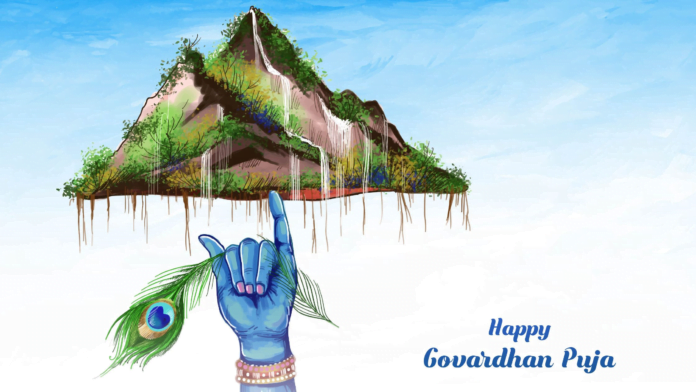
Govardhan Puja, also known as Annakut, is a Hindu festival celebrated with great enthusiasm and devotion in India, especially in the northern states. It falls on the fourth day of Diwali, which usually occurs in the month of October or November. This festival holds a significant place in Hindu mythology and is celebrated to commemorate an event from the life of Lord Krishna. Govardhan Puja is a day of expressing gratitude, community bonding, and fostering a sense of responsibility towards the environment.
The Legend of Govardhan Puja:
The origins of Govardhan Puja can be traced back to the Bhagavata Purana, an ancient Hindu scripture. The story behind the celebration revolves around Lord Krishna’s divine intervention to protect the people of the town of Vrindavan from the wrath of Lord Indra, the god of rain and thunderstorms. According to the legend, the residents of Vrindavan used to worship Lord Indra to ensure a bountiful harvest and good weather. However, young Lord Krishna advised them to worship Govardhan Parvat (mountain) instead, emphasizing the importance of nature and the environment.
In a fit of anger, Lord Indra sent torrential rains and thunderstorms to punish the people of Vrindavan for disobeying him. To protect the residents from the deluge, Lord Krishna lifted the massive Govardhan Parvat on his little finger for seven days and nights, providing them shelter from the elements. Realising the futility of his actions, Lord Indra withdrew the storm, and peace was restored.
The significance of Govardhan Puja:
Gratitude towards nature: Govardhan Puja serves as a reminder of the reverence Hindus have for nature. The act of worshiping the Govardhan Parvat represents gratitude towards the Earth and its resources, which sustain life and provide for the community.
Environmental consciousness: The story of Lord Krishna lifting the mountain to protect the people underscores the importance of responsible environmental stewardship. Govardhan Puja encourages people to appreciate and care for the environment and its resources.
Community bonding: This festival brings communities together as they collectively prepare a massive feast called “Annakut” consisting of a wide variety of vegetarian dishes. The food is offered to deities and then distributed among the community members, emphasizing the spirit of sharing and togetherness.
Spiritual significance: Govardhan Puja holds a spiritual significance as it teaches the importance of faith and devotion in overcoming adversities. Lord Krishna’s act of protecting the people of Vrindavan through divine intervention is seen as a symbol of hope and faith.
Celebrations and Rituals:
On Govardhan Puja, devotees create a replica of the Govardhan Parvat using cow dung, clay, or other materials. This representation is decorated with flowers and food items to offer to the deities. People also prepare an array of vegetarian dishes, sweets, and traditional foods as an offering to Lord Krishna. These offerings are later distributed among the community members, emphasizing the spirit of sharing and unity.
Govardhan Puja is a significant Hindu festival that celebrates nature, community, and the power of faith. It reminds us to be grateful for the environment that sustains us and to take responsibility for its well-being. As we celebrate Govardhan Puja, we should also reflect on the timeless lessons of this festival and incorporate them into our daily lives to foster a sense of environmental consciousness, unity, and gratitude.

